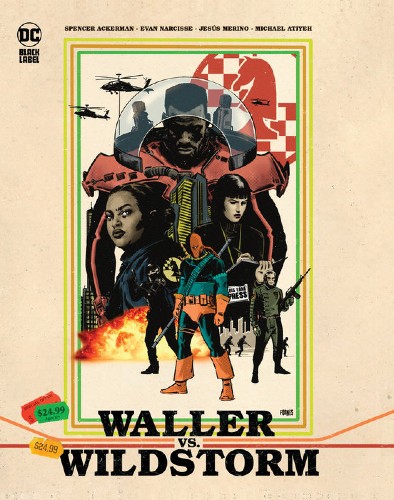Global Politics, With a Side of Superpowers: On “Waller vs. Wildstorm”

I don’t know if it’s quite reached the level of a trope, but the idea of just what effect superpowers and super-powered individuals would have on global politics is something plenty of writers and artists have reckoned with over the years. Kieron Gillen and Caspar Wijngaard’s The Power Fantasy, debuting later this year, is set to be the latest example of this, but it’s far from the only one.
The 1980s brought readers Miracleman, Squadron Supreme, and Watchmen. Marvel Comics’ New Universe imprint came to a close in 1989 with the miniseries The Draft, which featured metahumans drafted into a third Word War between the United States and the Soviet Union. And 1999 saw the publication of JLA: Superpower, by writer John Arcudi and artists Scot Eaton and Ray Kryssing, which explored why the Justice League didn’t simply overthrow a Saddam Hussein-like dictator.

Largely, though, superheroes and politics tend to blend most effectively outside of a shared universe. A thematic trilogy from writer Warren Ellis and artists Juan Jose Ryp and Garrie Gastonny — Black Summer, No Hero, and Supergod — explored the effects of superhuman abilities in different political contexts. Brett Lewis and John Paul Leon’s The Winter Men chronicled post-Soviet society through the eyes of a group of reluctant superheroes. And then there’s Deniz Camp and Stipan Morian’s stunning 20th Century Men, which Tegan O’Neill described in The Comics Journal as “a book about empire without so much as a shred of nostalgia for empire.”
And yet here we are, discussing a comic that’s absolutely set in a shared universe, albeit without much continuity baggage. That would be Waller Vs. Wildstorm, from writers Spencer Ackerman and Evan Narcisse and artist Jesús Merino. And this one has some characters in it that even readers without an encyclopedic knowledge of the genre will likely recognize, including Lois Lane, here depicted as a reporter early in her career. Amanda Waller, who’s been a mainstay of most film and TV DC adaptations recently, is at the center of the book — also a bit earlier in her career than the well-connected government operative that she’s usually presented as.
What Ackerman and Narcisse have done here is to present many of the superheroes associated with Wildstorm — the Jim Lee-founded publisher that began life as an Image imprint and was eventually purchased by DC — as being active during the Cold War and its aftermath, making them predecessors to DC’s more well-known roster of heroes. The most prominent of their number is one Jackson King, also known as Battalion — and the costume in which he appears is, shall we say, very 90s.
King’s tenure in the original Wildstorm comics as the leader of Stormwatch gives the political spin of this book an interesting touch. The 2004 “Revolution” storyline from writer Ed Brubaker and artist Dustin Nguyen found the Authority — the successors to Stormwatch — deposing the U.S. government and becoming a kind of head of state. All of which is to say that there’s precedent here for using the Wildstorm characters in this context.
The series is centered around three characters: King; Lane; and Waller, here portrayed as an ambitious mid-level officer in the international organization Checkmate. Structurally, each of its four parts has a distinctive feel and structure. The first largely centers around Lane interviewing King and King’s gradual discovery that the national security apparatus has grown corrupt. The second part provides a greater glimpse into King’s investigation and Waller’s machinations, while the third contains a lengthy and visceral fight scene that brings certain plot threads to a close. Waller is in the spotlight for the final section, in which we learn the full scope of her ambitions.
There’s plenty of narrative subversion happening here, too. Jesús Merino does a fine job of making the book’s talkier elements — this is a book with lots of interviews and meetings — visually interesting, and the action sequences, when they come, feel appropriately big. There’s an image of Jackson King in full costume flying into battle that looks like precisely what it is: a noble hero heading into battle full of righteous anger. In a more traditional superhero storyline, this would lead to a cathartic moment. In this book, the outcome is a little different.
It’s one of a few narrative beats where the whole creative team upends expectations. See also: a sequence late in the book of one character traveling into space. There’s plenty of room here for the sense of wonder that comes from many superhero comics, only here the context is deeply, deeply cynical. This is also a graphic novel with a few explicit nods to contemporary geopolitics — notably, a scene where Slade Wilson, one of the book’s villains, uses the phrase “shithole country.”
Waller vs. Wildstorm is also notable for the rigor with which its plot unfolds. Narcisse and Ackerman have written a book that echoes the reporter at the center of its plot, and its storyline meticulously finds the connections between metahumans and political atrocities. In his newsletter Forever Wars, Ackerman has described this book as a sibling to his nonfiction work Reign of Terror. It might seem like an unlikely claim, but it clicks into place beatifically here. Readers might eye the presence of Waller and Deathstroke on the cover and pick this one up, but they’ll also learn plenty about black sites, economically benefiting sociopaths, and the fog of geopolitical cold war. Turns out, in the right hands, the prehistory of the DC universe can illuminate the bleaker corners of our own world.